LAWS20059 Corporate Law Assignment: Insolvency, Partnership, and Cases
VerifiedAdded on 2022/10/15
|11
|3150
|14
Homework Assignment
AI Summary
This assignment solution addresses key concepts in corporate law, specifically focusing on insolvency and partnership. Question 1 analyzes the legal definition of insolvency under the Corporations Act 2001 (Cth), explaining the cash flow and balance sheet tests used to determine a company's financial distress, and the types of evidence used to establish insolvency. Question 2 examines the concept of partnership through the case of Canny Gabriel Castle Jackson Advertising Pty Ltd v Volume Sales (Finance) Pty Ltd (1974), comparing the application of partnership laws in New South Wales and Queensland. The solution applies the Partnership Act 1982 (NSW) and Partnership Act 1891 (Queensland) to determine whether a partnership existed. The assignment concludes with a brief reference to a case involving Gunns Plantations Limited. The solution provides detailed legal analysis and applies relevant legislation and case law to support its arguments.
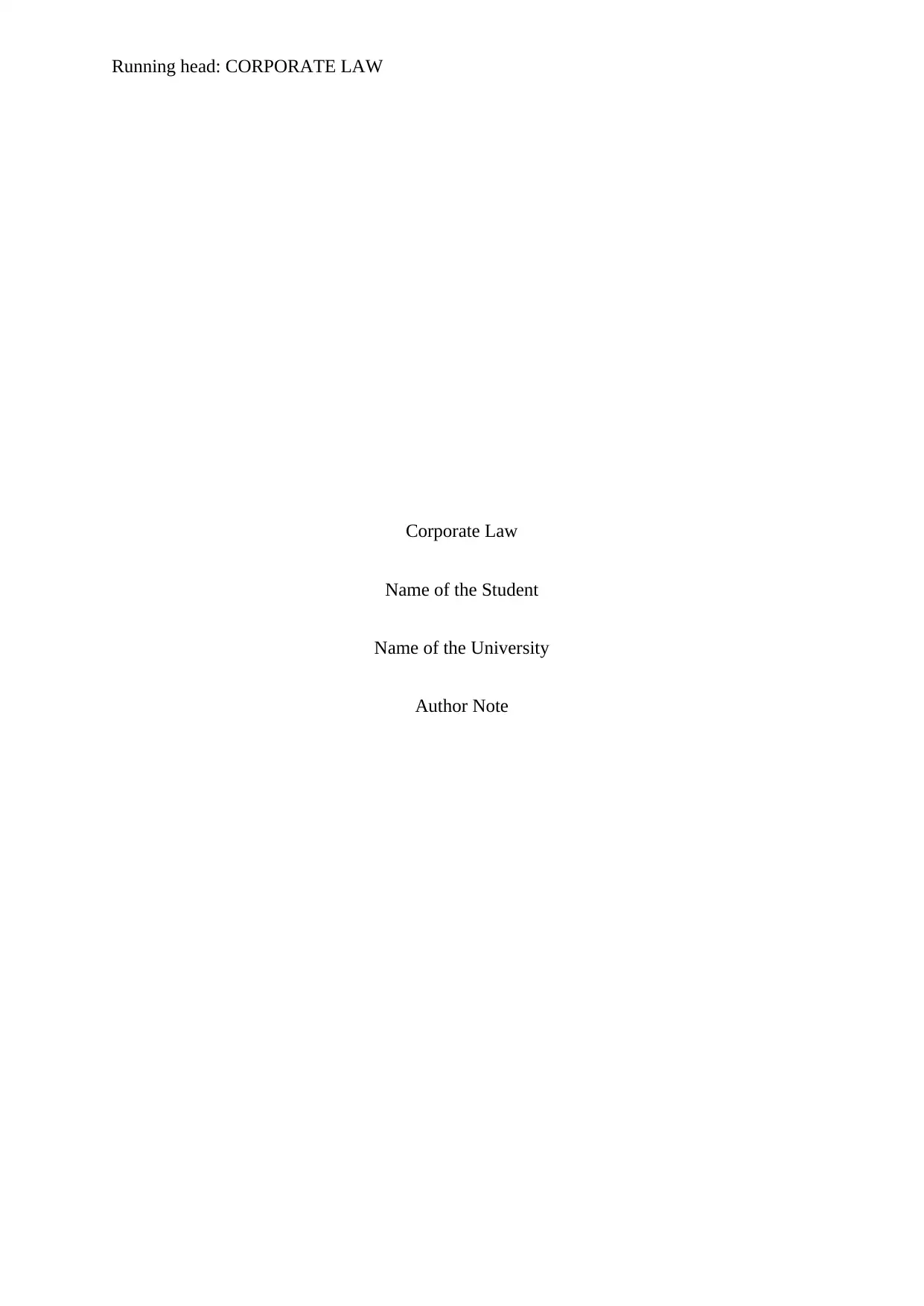
Running head: CORPORATE LAW
Corporate Law
Name of the Student
Name of the University
Author Note
Corporate Law
Name of the Student
Name of the University
Author Note
Paraphrase This Document
Need a fresh take? Get an instant paraphrase of this document with our AI Paraphraser
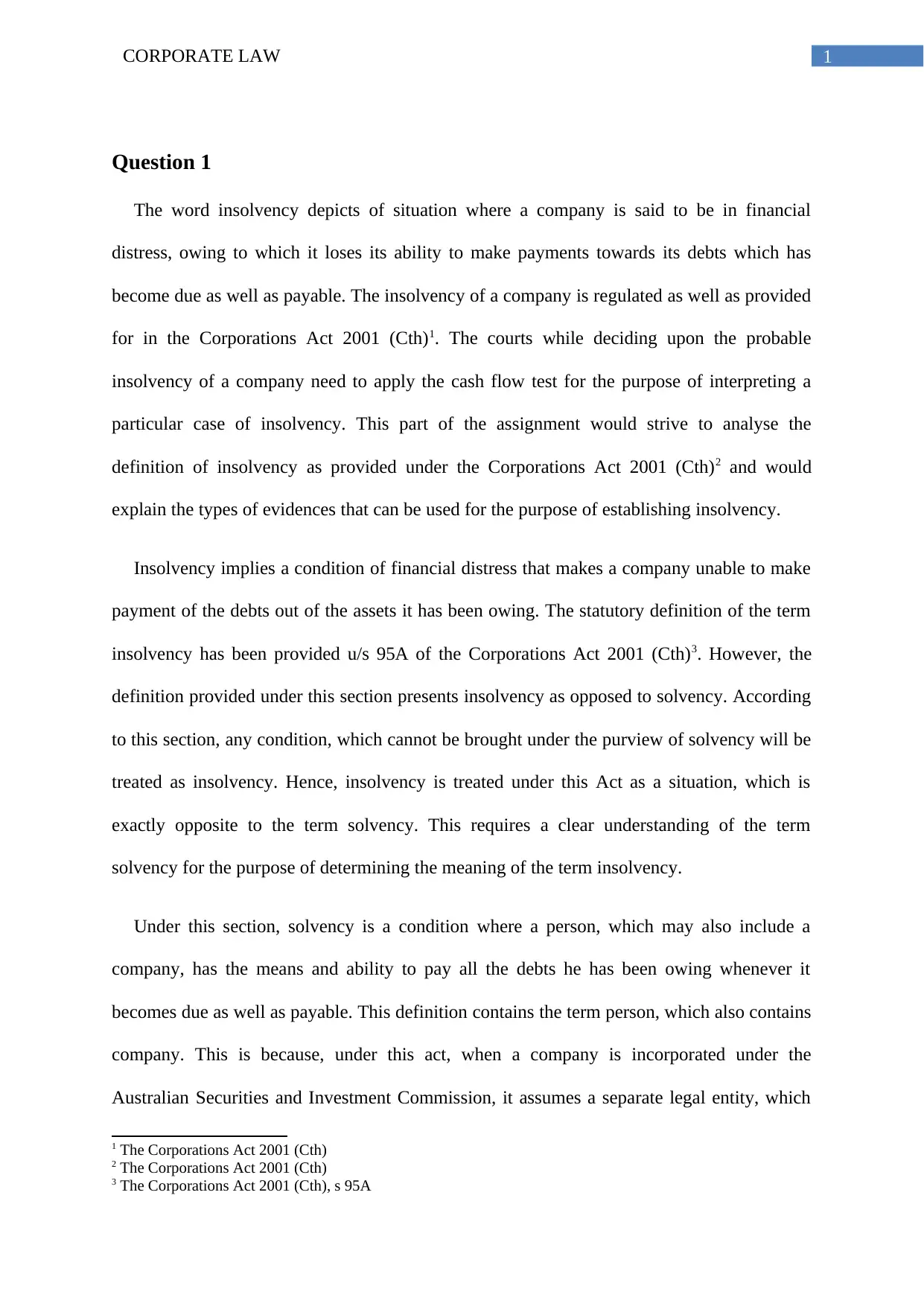
1CORPORATE LAW
Question 1
The word insolvency depicts of situation where a company is said to be in financial
distress, owing to which it loses its ability to make payments towards its debts which has
become due as well as payable. The insolvency of a company is regulated as well as provided
for in the Corporations Act 2001 (Cth)1. The courts while deciding upon the probable
insolvency of a company need to apply the cash flow test for the purpose of interpreting a
particular case of insolvency. This part of the assignment would strive to analyse the
definition of insolvency as provided under the Corporations Act 2001 (Cth)2 and would
explain the types of evidences that can be used for the purpose of establishing insolvency.
Insolvency implies a condition of financial distress that makes a company unable to make
payment of the debts out of the assets it has been owing. The statutory definition of the term
insolvency has been provided u/s 95A of the Corporations Act 2001 (Cth)3. However, the
definition provided under this section presents insolvency as opposed to solvency. According
to this section, any condition, which cannot be brought under the purview of solvency will be
treated as insolvency. Hence, insolvency is treated under this Act as a situation, which is
exactly opposite to the term solvency. This requires a clear understanding of the term
solvency for the purpose of determining the meaning of the term insolvency.
Under this section, solvency is a condition where a person, which may also include a
company, has the means and ability to pay all the debts he has been owing whenever it
becomes due as well as payable. This definition contains the term person, which also contains
company. This is because, under this act, when a company is incorporated under the
Australian Securities and Investment Commission, it assumes a separate legal entity, which
1 The Corporations Act 2001 (Cth)
2 The Corporations Act 2001 (Cth)
3 The Corporations Act 2001 (Cth), s 95A
Question 1
The word insolvency depicts of situation where a company is said to be in financial
distress, owing to which it loses its ability to make payments towards its debts which has
become due as well as payable. The insolvency of a company is regulated as well as provided
for in the Corporations Act 2001 (Cth)1. The courts while deciding upon the probable
insolvency of a company need to apply the cash flow test for the purpose of interpreting a
particular case of insolvency. This part of the assignment would strive to analyse the
definition of insolvency as provided under the Corporations Act 2001 (Cth)2 and would
explain the types of evidences that can be used for the purpose of establishing insolvency.
Insolvency implies a condition of financial distress that makes a company unable to make
payment of the debts out of the assets it has been owing. The statutory definition of the term
insolvency has been provided u/s 95A of the Corporations Act 2001 (Cth)3. However, the
definition provided under this section presents insolvency as opposed to solvency. According
to this section, any condition, which cannot be brought under the purview of solvency will be
treated as insolvency. Hence, insolvency is treated under this Act as a situation, which is
exactly opposite to the term solvency. This requires a clear understanding of the term
solvency for the purpose of determining the meaning of the term insolvency.
Under this section, solvency is a condition where a person, which may also include a
company, has the means and ability to pay all the debts he has been owing whenever it
becomes due as well as payable. This definition contains the term person, which also contains
company. This is because, under this act, when a company is incorporated under the
Australian Securities and Investment Commission, it assumes a separate legal entity, which
1 The Corporations Act 2001 (Cth)
2 The Corporations Act 2001 (Cth)
3 The Corporations Act 2001 (Cth), s 95A
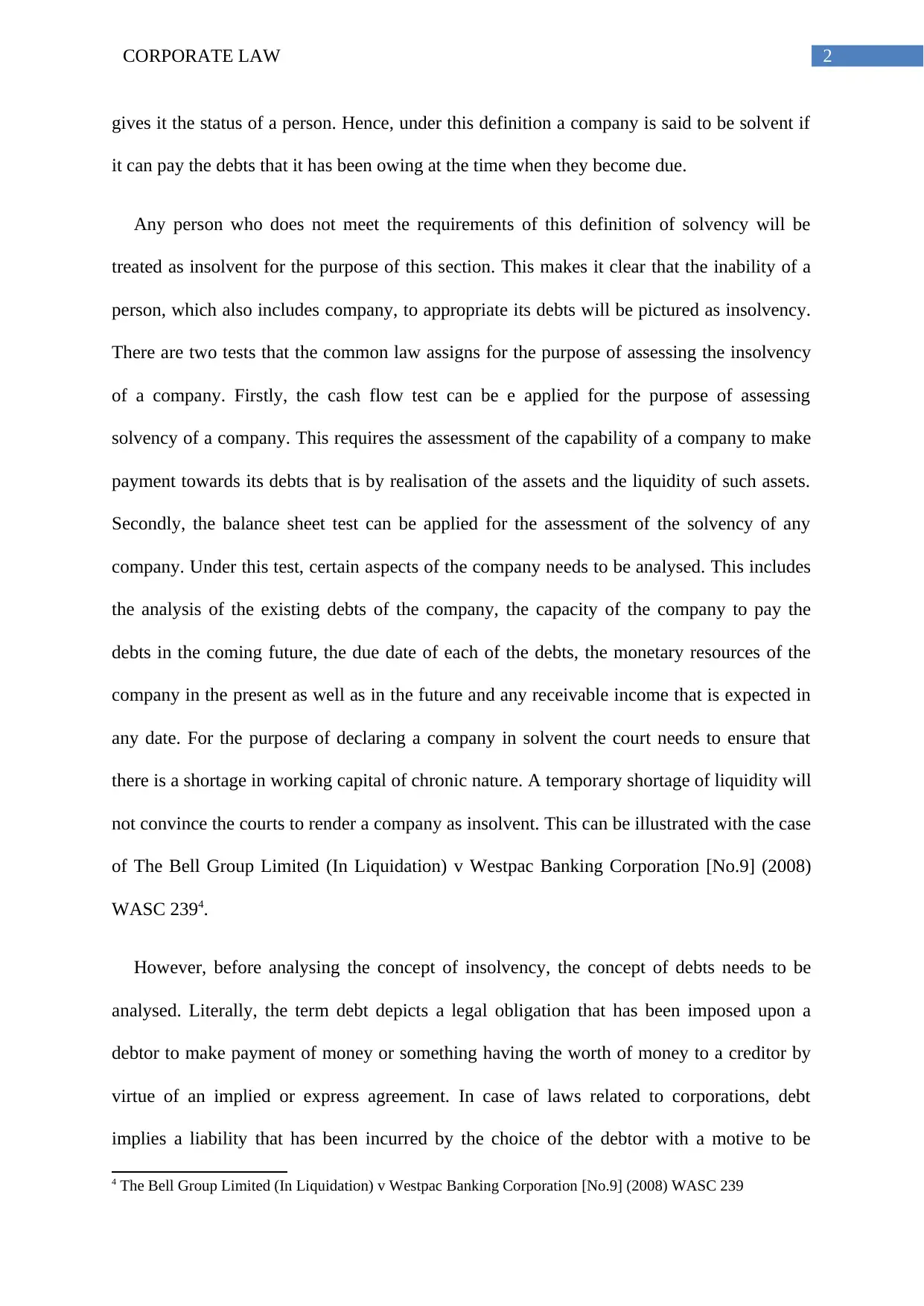
2CORPORATE LAW
gives it the status of a person. Hence, under this definition a company is said to be solvent if
it can pay the debts that it has been owing at the time when they become due.
Any person who does not meet the requirements of this definition of solvency will be
treated as insolvent for the purpose of this section. This makes it clear that the inability of a
person, which also includes company, to appropriate its debts will be pictured as insolvency.
There are two tests that the common law assigns for the purpose of assessing the insolvency
of a company. Firstly, the cash flow test can be e applied for the purpose of assessing
solvency of a company. This requires the assessment of the capability of a company to make
payment towards its debts that is by realisation of the assets and the liquidity of such assets.
Secondly, the balance sheet test can be applied for the assessment of the solvency of any
company. Under this test, certain aspects of the company needs to be analysed. This includes
the analysis of the existing debts of the company, the capacity of the company to pay the
debts in the coming future, the due date of each of the debts, the monetary resources of the
company in the present as well as in the future and any receivable income that is expected in
any date. For the purpose of declaring a company in solvent the court needs to ensure that
there is a shortage in working capital of chronic nature. A temporary shortage of liquidity will
not convince the courts to render a company as insolvent. This can be illustrated with the case
of The Bell Group Limited (In Liquidation) v Westpac Banking Corporation [No.9] (2008)
WASC 2394.
However, before analysing the concept of insolvency, the concept of debts needs to be
analysed. Literally, the term debt depicts a legal obligation that has been imposed upon a
debtor to make payment of money or something having the worth of money to a creditor by
virtue of an implied or express agreement. In case of laws related to corporations, debt
implies a liability that has been incurred by the choice of the debtor with a motive to be
4 The Bell Group Limited (In Liquidation) v Westpac Banking Corporation [No.9] (2008) WASC 239
gives it the status of a person. Hence, under this definition a company is said to be solvent if
it can pay the debts that it has been owing at the time when they become due.
Any person who does not meet the requirements of this definition of solvency will be
treated as insolvent for the purpose of this section. This makes it clear that the inability of a
person, which also includes company, to appropriate its debts will be pictured as insolvency.
There are two tests that the common law assigns for the purpose of assessing the insolvency
of a company. Firstly, the cash flow test can be e applied for the purpose of assessing
solvency of a company. This requires the assessment of the capability of a company to make
payment towards its debts that is by realisation of the assets and the liquidity of such assets.
Secondly, the balance sheet test can be applied for the assessment of the solvency of any
company. Under this test, certain aspects of the company needs to be analysed. This includes
the analysis of the existing debts of the company, the capacity of the company to pay the
debts in the coming future, the due date of each of the debts, the monetary resources of the
company in the present as well as in the future and any receivable income that is expected in
any date. For the purpose of declaring a company in solvent the court needs to ensure that
there is a shortage in working capital of chronic nature. A temporary shortage of liquidity will
not convince the courts to render a company as insolvent. This can be illustrated with the case
of The Bell Group Limited (In Liquidation) v Westpac Banking Corporation [No.9] (2008)
WASC 2394.
However, before analysing the concept of insolvency, the concept of debts needs to be
analysed. Literally, the term debt depicts a legal obligation that has been imposed upon a
debtor to make payment of money or something having the worth of money to a creditor by
virtue of an implied or express agreement. In case of laws related to corporations, debt
implies a liability that has been incurred by the choice of the debtor with a motive to be
4 The Bell Group Limited (In Liquidation) v Westpac Banking Corporation [No.9] (2008) WASC 239
⊘ This is a preview!⊘
Do you want full access?
Subscribe today to unlock all pages.

Trusted by 1+ million students worldwide
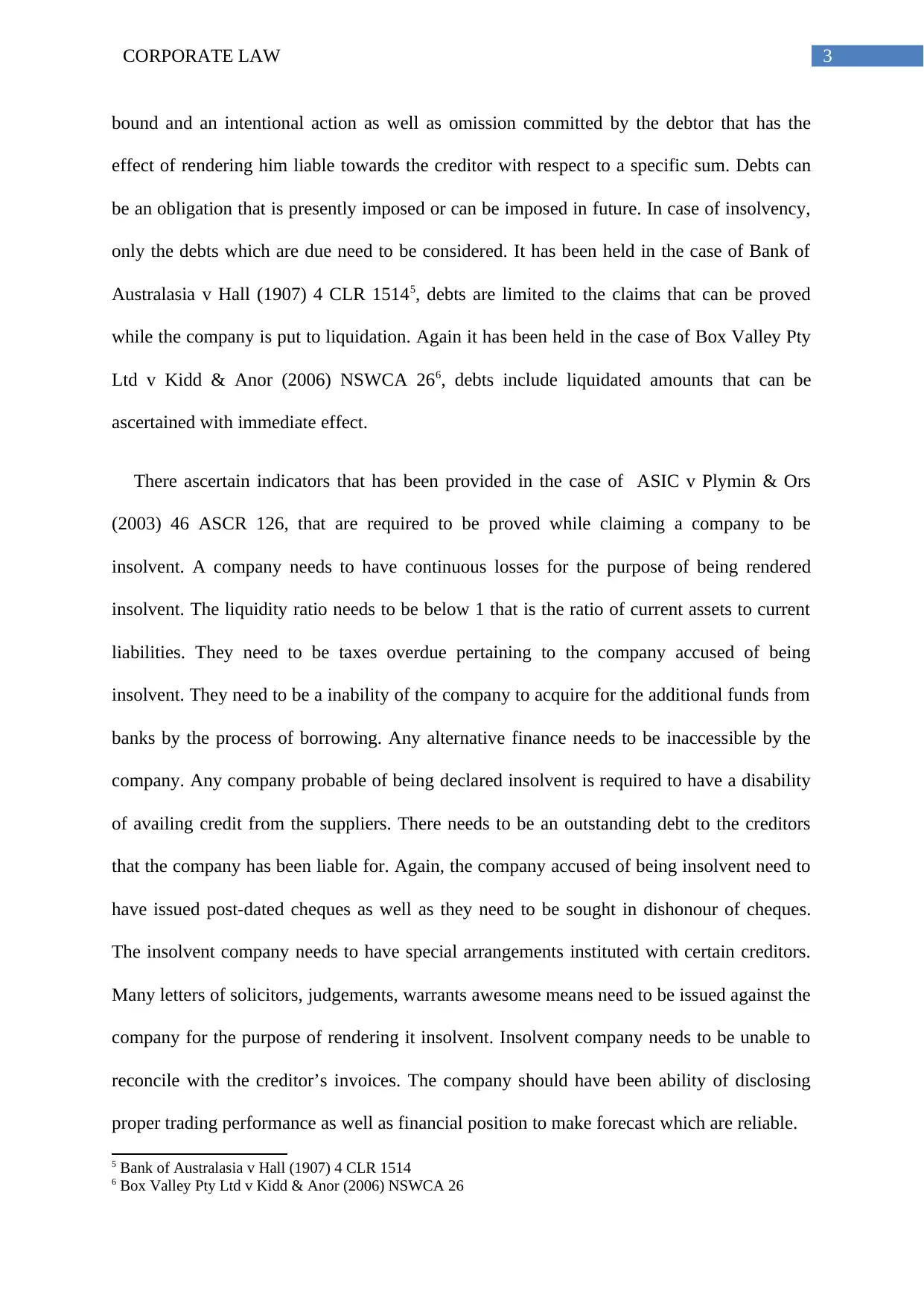
3CORPORATE LAW
bound and an intentional action as well as omission committed by the debtor that has the
effect of rendering him liable towards the creditor with respect to a specific sum. Debts can
be an obligation that is presently imposed or can be imposed in future. In case of insolvency,
only the debts which are due need to be considered. It has been held in the case of Bank of
Australasia v Hall (1907) 4 CLR 15145, debts are limited to the claims that can be proved
while the company is put to liquidation. Again it has been held in the case of Box Valley Pty
Ltd v Kidd & Anor (2006) NSWCA 266, debts include liquidated amounts that can be
ascertained with immediate effect.
There ascertain indicators that has been provided in the case of ASIC v Plymin & Ors
(2003) 46 ASCR 126, that are required to be proved while claiming a company to be
insolvent. A company needs to have continuous losses for the purpose of being rendered
insolvent. The liquidity ratio needs to be below 1 that is the ratio of current assets to current
liabilities. They need to be taxes overdue pertaining to the company accused of being
insolvent. They need to be a inability of the company to acquire for the additional funds from
banks by the process of borrowing. Any alternative finance needs to be inaccessible by the
company. Any company probable of being declared insolvent is required to have a disability
of availing credit from the suppliers. There needs to be an outstanding debt to the creditors
that the company has been liable for. Again, the company accused of being insolvent need to
have issued post-dated cheques as well as they need to be sought in dishonour of cheques.
The insolvent company needs to have special arrangements instituted with certain creditors.
Many letters of solicitors, judgements, warrants awesome means need to be issued against the
company for the purpose of rendering it insolvent. Insolvent company needs to be unable to
reconcile with the creditor’s invoices. The company should have been ability of disclosing
proper trading performance as well as financial position to make forecast which are reliable.
5 Bank of Australasia v Hall (1907) 4 CLR 1514
6 Box Valley Pty Ltd v Kidd & Anor (2006) NSWCA 26
bound and an intentional action as well as omission committed by the debtor that has the
effect of rendering him liable towards the creditor with respect to a specific sum. Debts can
be an obligation that is presently imposed or can be imposed in future. In case of insolvency,
only the debts which are due need to be considered. It has been held in the case of Bank of
Australasia v Hall (1907) 4 CLR 15145, debts are limited to the claims that can be proved
while the company is put to liquidation. Again it has been held in the case of Box Valley Pty
Ltd v Kidd & Anor (2006) NSWCA 266, debts include liquidated amounts that can be
ascertained with immediate effect.
There ascertain indicators that has been provided in the case of ASIC v Plymin & Ors
(2003) 46 ASCR 126, that are required to be proved while claiming a company to be
insolvent. A company needs to have continuous losses for the purpose of being rendered
insolvent. The liquidity ratio needs to be below 1 that is the ratio of current assets to current
liabilities. They need to be taxes overdue pertaining to the company accused of being
insolvent. They need to be a inability of the company to acquire for the additional funds from
banks by the process of borrowing. Any alternative finance needs to be inaccessible by the
company. Any company probable of being declared insolvent is required to have a disability
of availing credit from the suppliers. There needs to be an outstanding debt to the creditors
that the company has been liable for. Again, the company accused of being insolvent need to
have issued post-dated cheques as well as they need to be sought in dishonour of cheques.
The insolvent company needs to have special arrangements instituted with certain creditors.
Many letters of solicitors, judgements, warrants awesome means need to be issued against the
company for the purpose of rendering it insolvent. Insolvent company needs to be unable to
reconcile with the creditor’s invoices. The company should have been ability of disclosing
proper trading performance as well as financial position to make forecast which are reliable.
5 Bank of Australasia v Hall (1907) 4 CLR 1514
6 Box Valley Pty Ltd v Kidd & Anor (2006) NSWCA 26
Paraphrase This Document
Need a fresh take? Get an instant paraphrase of this document with our AI Paraphraser
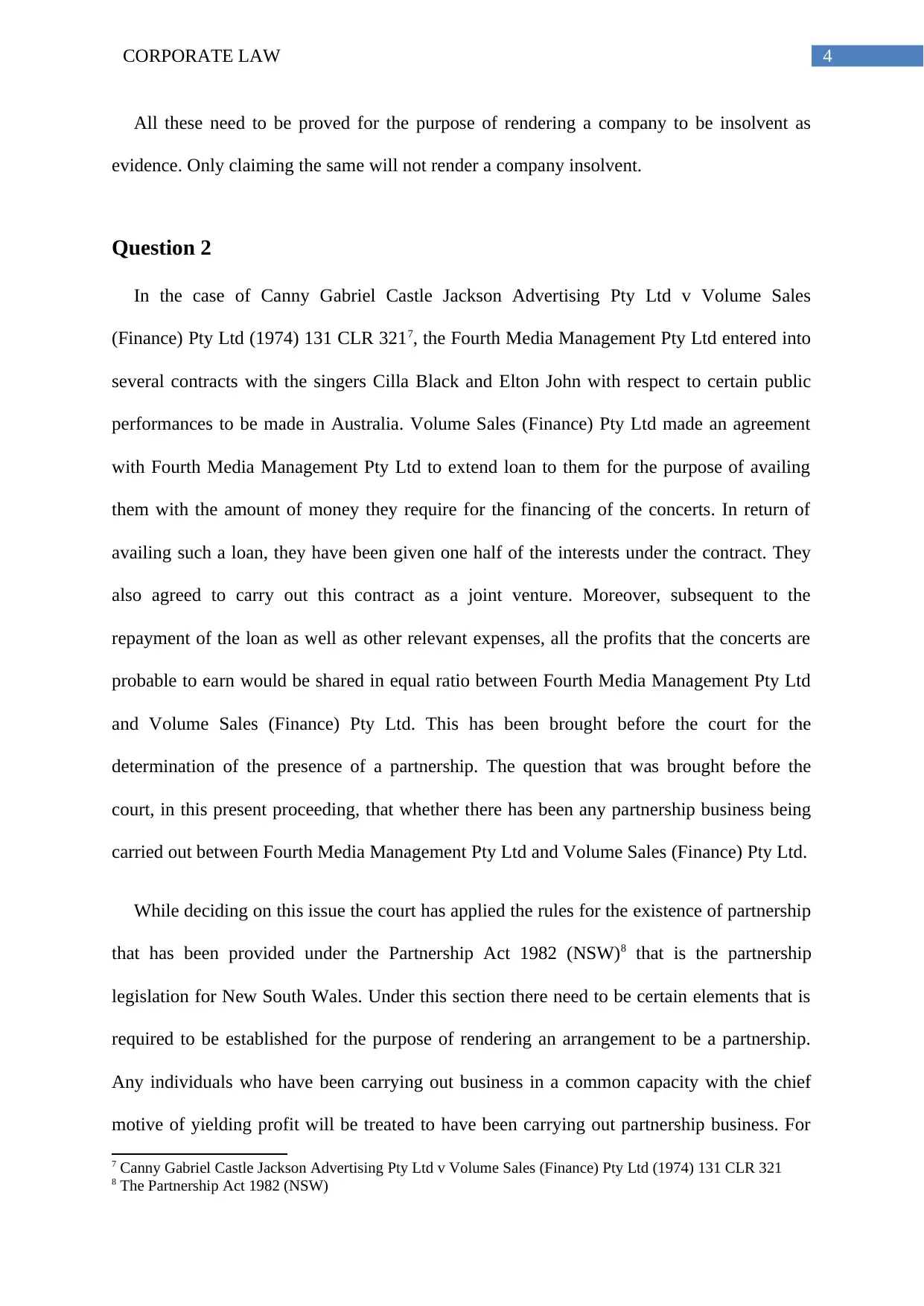
4CORPORATE LAW
All these need to be proved for the purpose of rendering a company to be insolvent as
evidence. Only claiming the same will not render a company insolvent.
Question 2
In the case of Canny Gabriel Castle Jackson Advertising Pty Ltd v Volume Sales
(Finance) Pty Ltd (1974) 131 CLR 3217, the Fourth Media Management Pty Ltd entered into
several contracts with the singers Cilla Black and Elton John with respect to certain public
performances to be made in Australia. Volume Sales (Finance) Pty Ltd made an agreement
with Fourth Media Management Pty Ltd to extend loan to them for the purpose of availing
them with the amount of money they require for the financing of the concerts. In return of
availing such a loan, they have been given one half of the interests under the contract. They
also agreed to carry out this contract as a joint venture. Moreover, subsequent to the
repayment of the loan as well as other relevant expenses, all the profits that the concerts are
probable to earn would be shared in equal ratio between Fourth Media Management Pty Ltd
and Volume Sales (Finance) Pty Ltd. This has been brought before the court for the
determination of the presence of a partnership. The question that was brought before the
court, in this present proceeding, that whether there has been any partnership business being
carried out between Fourth Media Management Pty Ltd and Volume Sales (Finance) Pty Ltd.
While deciding on this issue the court has applied the rules for the existence of partnership
that has been provided under the Partnership Act 1982 (NSW)8 that is the partnership
legislation for New South Wales. Under this section there need to be certain elements that is
required to be established for the purpose of rendering an arrangement to be a partnership.
Any individuals who have been carrying out business in a common capacity with the chief
motive of yielding profit will be treated to have been carrying out partnership business. For
7 Canny Gabriel Castle Jackson Advertising Pty Ltd v Volume Sales (Finance) Pty Ltd (1974) 131 CLR 321
8 The Partnership Act 1982 (NSW)
All these need to be proved for the purpose of rendering a company to be insolvent as
evidence. Only claiming the same will not render a company insolvent.
Question 2
In the case of Canny Gabriel Castle Jackson Advertising Pty Ltd v Volume Sales
(Finance) Pty Ltd (1974) 131 CLR 3217, the Fourth Media Management Pty Ltd entered into
several contracts with the singers Cilla Black and Elton John with respect to certain public
performances to be made in Australia. Volume Sales (Finance) Pty Ltd made an agreement
with Fourth Media Management Pty Ltd to extend loan to them for the purpose of availing
them with the amount of money they require for the financing of the concerts. In return of
availing such a loan, they have been given one half of the interests under the contract. They
also agreed to carry out this contract as a joint venture. Moreover, subsequent to the
repayment of the loan as well as other relevant expenses, all the profits that the concerts are
probable to earn would be shared in equal ratio between Fourth Media Management Pty Ltd
and Volume Sales (Finance) Pty Ltd. This has been brought before the court for the
determination of the presence of a partnership. The question that was brought before the
court, in this present proceeding, that whether there has been any partnership business being
carried out between Fourth Media Management Pty Ltd and Volume Sales (Finance) Pty Ltd.
While deciding on this issue the court has applied the rules for the existence of partnership
that has been provided under the Partnership Act 1982 (NSW)8 that is the partnership
legislation for New South Wales. Under this section there need to be certain elements that is
required to be established for the purpose of rendering an arrangement to be a partnership.
Any individuals who have been carrying out business in a common capacity with the chief
motive of yielding profit will be treated to have been carrying out partnership business. For
7 Canny Gabriel Castle Jackson Advertising Pty Ltd v Volume Sales (Finance) Pty Ltd (1974) 131 CLR 321
8 The Partnership Act 1982 (NSW)
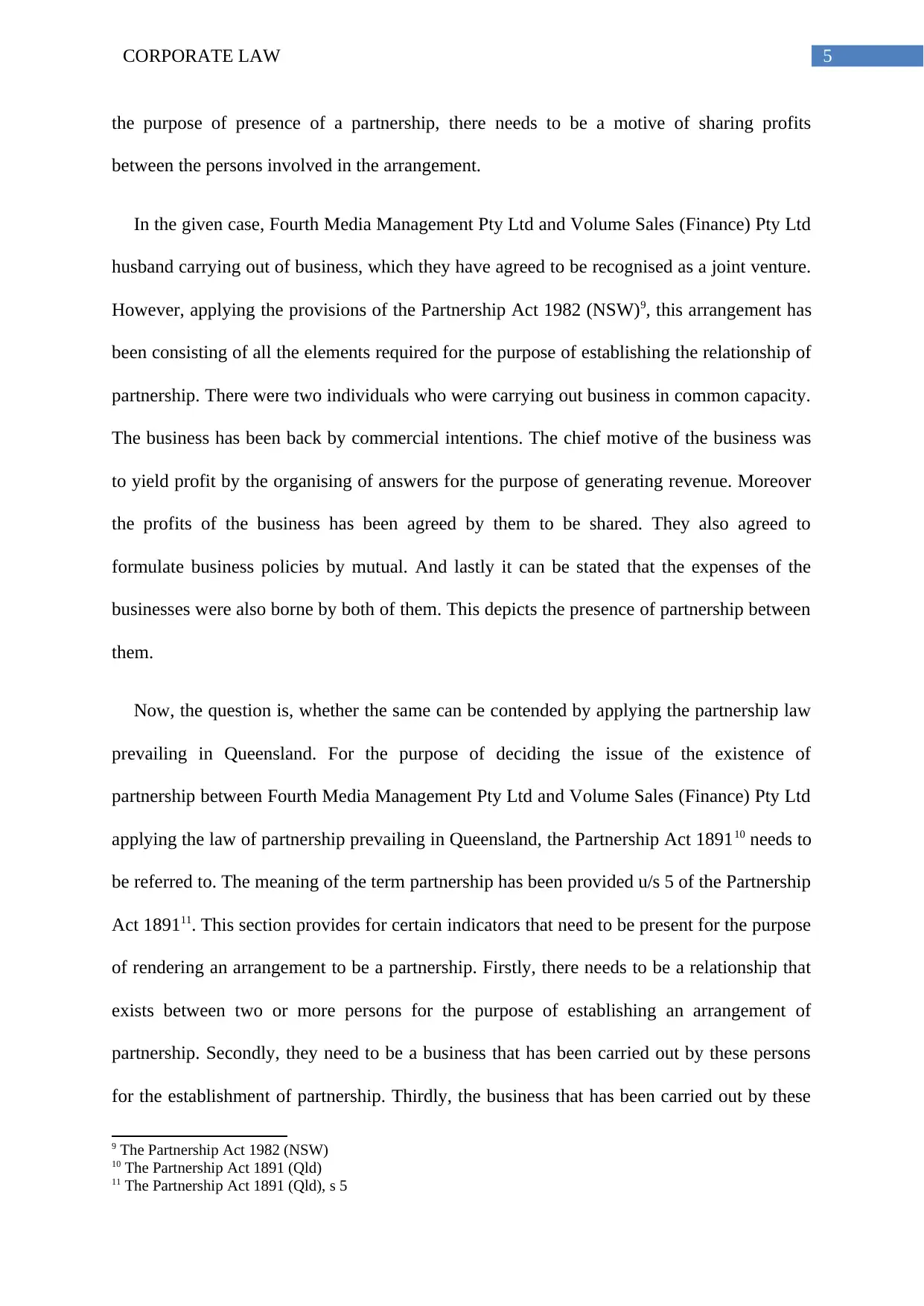
5CORPORATE LAW
the purpose of presence of a partnership, there needs to be a motive of sharing profits
between the persons involved in the arrangement.
In the given case, Fourth Media Management Pty Ltd and Volume Sales (Finance) Pty Ltd
husband carrying out of business, which they have agreed to be recognised as a joint venture.
However, applying the provisions of the Partnership Act 1982 (NSW)9, this arrangement has
been consisting of all the elements required for the purpose of establishing the relationship of
partnership. There were two individuals who were carrying out business in common capacity.
The business has been back by commercial intentions. The chief motive of the business was
to yield profit by the organising of answers for the purpose of generating revenue. Moreover
the profits of the business has been agreed by them to be shared. They also agreed to
formulate business policies by mutual. And lastly it can be stated that the expenses of the
businesses were also borne by both of them. This depicts the presence of partnership between
them.
Now, the question is, whether the same can be contended by applying the partnership law
prevailing in Queensland. For the purpose of deciding the issue of the existence of
partnership between Fourth Media Management Pty Ltd and Volume Sales (Finance) Pty Ltd
applying the law of partnership prevailing in Queensland, the Partnership Act 189110 needs to
be referred to. The meaning of the term partnership has been provided u/s 5 of the Partnership
Act 189111. This section provides for certain indicators that need to be present for the purpose
of rendering an arrangement to be a partnership. Firstly, there needs to be a relationship that
exists between two or more persons for the purpose of establishing an arrangement of
partnership. Secondly, they need to be a business that has been carried out by these persons
for the establishment of partnership. Thirdly, the business that has been carried out by these
9 The Partnership Act 1982 (NSW)
10 The Partnership Act 1891 (Qld)
11 The Partnership Act 1891 (Qld), s 5
the purpose of presence of a partnership, there needs to be a motive of sharing profits
between the persons involved in the arrangement.
In the given case, Fourth Media Management Pty Ltd and Volume Sales (Finance) Pty Ltd
husband carrying out of business, which they have agreed to be recognised as a joint venture.
However, applying the provisions of the Partnership Act 1982 (NSW)9, this arrangement has
been consisting of all the elements required for the purpose of establishing the relationship of
partnership. There were two individuals who were carrying out business in common capacity.
The business has been back by commercial intentions. The chief motive of the business was
to yield profit by the organising of answers for the purpose of generating revenue. Moreover
the profits of the business has been agreed by them to be shared. They also agreed to
formulate business policies by mutual. And lastly it can be stated that the expenses of the
businesses were also borne by both of them. This depicts the presence of partnership between
them.
Now, the question is, whether the same can be contended by applying the partnership law
prevailing in Queensland. For the purpose of deciding the issue of the existence of
partnership between Fourth Media Management Pty Ltd and Volume Sales (Finance) Pty Ltd
applying the law of partnership prevailing in Queensland, the Partnership Act 189110 needs to
be referred to. The meaning of the term partnership has been provided u/s 5 of the Partnership
Act 189111. This section provides for certain indicators that need to be present for the purpose
of rendering an arrangement to be a partnership. Firstly, there needs to be a relationship that
exists between two or more persons for the purpose of establishing an arrangement of
partnership. Secondly, they need to be a business that has been carried out by these persons
for the establishment of partnership. Thirdly, the business that has been carried out by these
9 The Partnership Act 1982 (NSW)
10 The Partnership Act 1891 (Qld)
11 The Partnership Act 1891 (Qld), s 5
⊘ This is a preview!⊘
Do you want full access?
Subscribe today to unlock all pages.

Trusted by 1+ million students worldwide
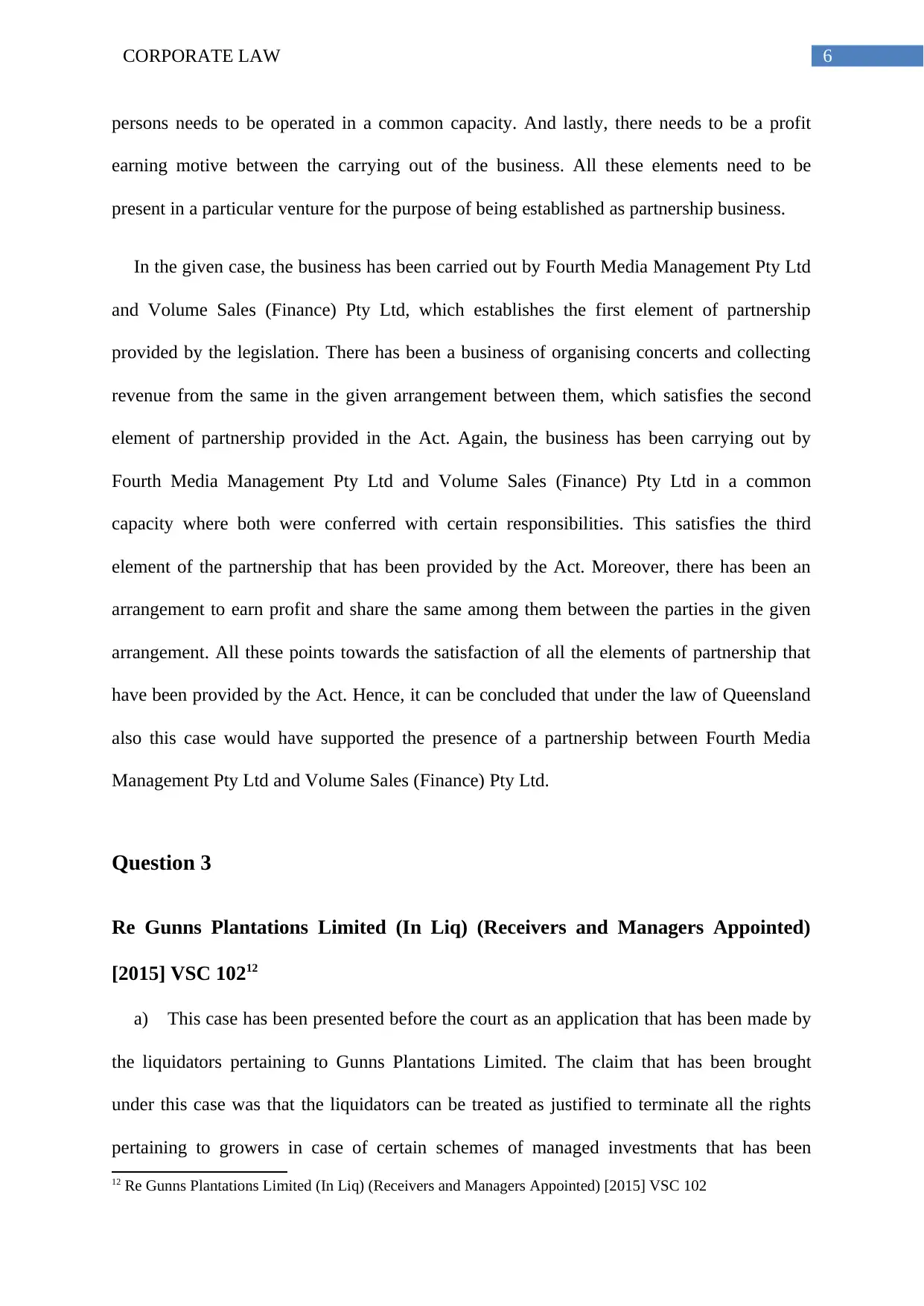
6CORPORATE LAW
persons needs to be operated in a common capacity. And lastly, there needs to be a profit
earning motive between the carrying out of the business. All these elements need to be
present in a particular venture for the purpose of being established as partnership business.
In the given case, the business has been carried out by Fourth Media Management Pty Ltd
and Volume Sales (Finance) Pty Ltd, which establishes the first element of partnership
provided by the legislation. There has been a business of organising concerts and collecting
revenue from the same in the given arrangement between them, which satisfies the second
element of partnership provided in the Act. Again, the business has been carrying out by
Fourth Media Management Pty Ltd and Volume Sales (Finance) Pty Ltd in a common
capacity where both were conferred with certain responsibilities. This satisfies the third
element of the partnership that has been provided by the Act. Moreover, there has been an
arrangement to earn profit and share the same among them between the parties in the given
arrangement. All these points towards the satisfaction of all the elements of partnership that
have been provided by the Act. Hence, it can be concluded that under the law of Queensland
also this case would have supported the presence of a partnership between Fourth Media
Management Pty Ltd and Volume Sales (Finance) Pty Ltd.
Question 3
Re Gunns Plantations Limited (In Liq) (Receivers and Managers Appointed)
[2015] VSC 10212
a) This case has been presented before the court as an application that has been made by
the liquidators pertaining to Gunns Plantations Limited. The claim that has been brought
under this case was that the liquidators can be treated as justified to terminate all the rights
pertaining to growers in case of certain schemes of managed investments that has been
12 Re Gunns Plantations Limited (In Liq) (Receivers and Managers Appointed) [2015] VSC 102
persons needs to be operated in a common capacity. And lastly, there needs to be a profit
earning motive between the carrying out of the business. All these elements need to be
present in a particular venture for the purpose of being established as partnership business.
In the given case, the business has been carried out by Fourth Media Management Pty Ltd
and Volume Sales (Finance) Pty Ltd, which establishes the first element of partnership
provided by the legislation. There has been a business of organising concerts and collecting
revenue from the same in the given arrangement between them, which satisfies the second
element of partnership provided in the Act. Again, the business has been carrying out by
Fourth Media Management Pty Ltd and Volume Sales (Finance) Pty Ltd in a common
capacity where both were conferred with certain responsibilities. This satisfies the third
element of the partnership that has been provided by the Act. Moreover, there has been an
arrangement to earn profit and share the same among them between the parties in the given
arrangement. All these points towards the satisfaction of all the elements of partnership that
have been provided by the Act. Hence, it can be concluded that under the law of Queensland
also this case would have supported the presence of a partnership between Fourth Media
Management Pty Ltd and Volume Sales (Finance) Pty Ltd.
Question 3
Re Gunns Plantations Limited (In Liq) (Receivers and Managers Appointed)
[2015] VSC 10212
a) This case has been presented before the court as an application that has been made by
the liquidators pertaining to Gunns Plantations Limited. The claim that has been brought
under this case was that the liquidators can be treated as justified to terminate all the rights
pertaining to growers in case of certain schemes of managed investments that has been
12 Re Gunns Plantations Limited (In Liq) (Receivers and Managers Appointed) [2015] VSC 102
Paraphrase This Document
Need a fresh take? Get an instant paraphrase of this document with our AI Paraphraser
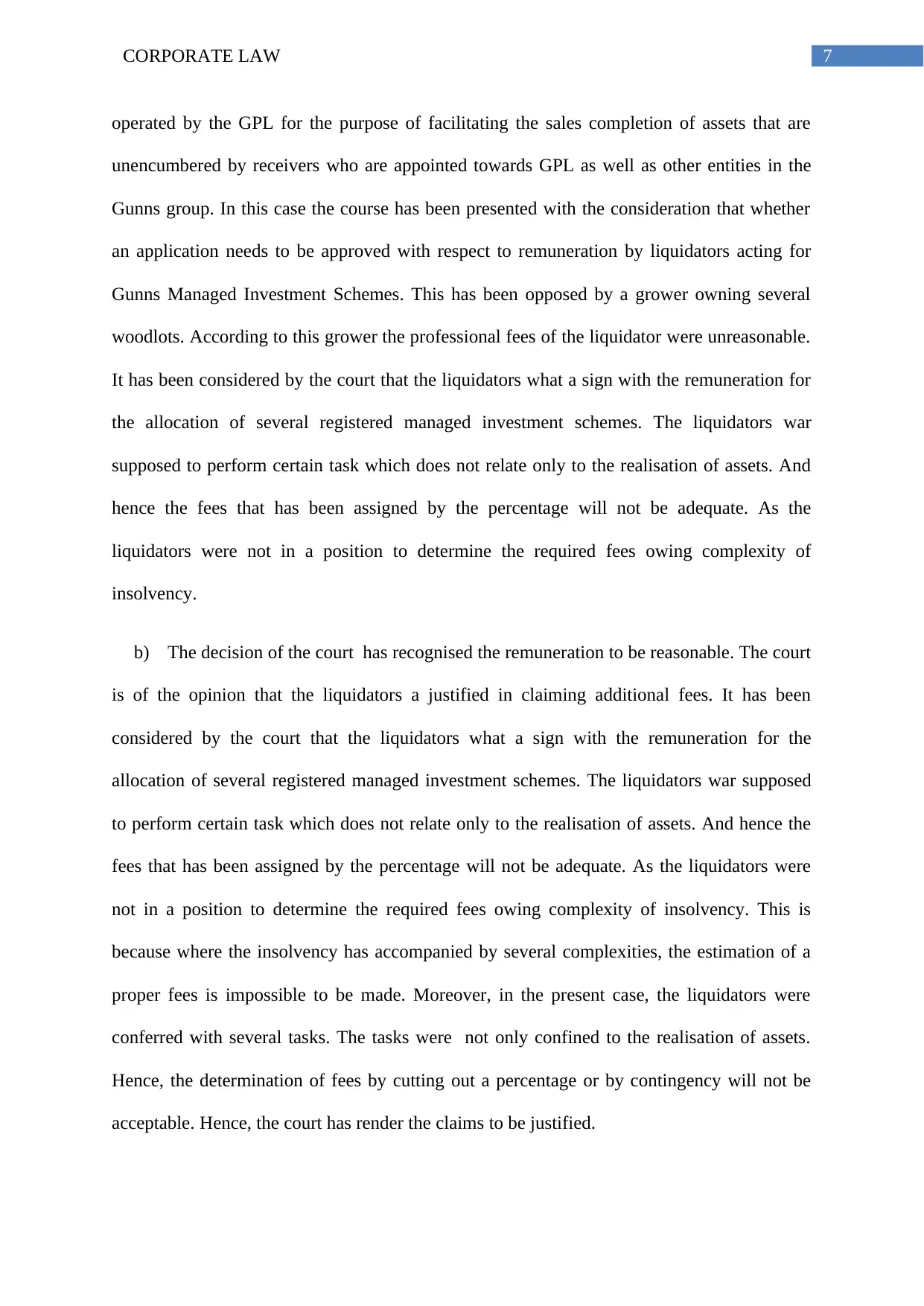
7CORPORATE LAW
operated by the GPL for the purpose of facilitating the sales completion of assets that are
unencumbered by receivers who are appointed towards GPL as well as other entities in the
Gunns group. In this case the course has been presented with the consideration that whether
an application needs to be approved with respect to remuneration by liquidators acting for
Gunns Managed Investment Schemes. This has been opposed by a grower owning several
woodlots. According to this grower the professional fees of the liquidator were unreasonable.
It has been considered by the court that the liquidators what a sign with the remuneration for
the allocation of several registered managed investment schemes. The liquidators war
supposed to perform certain task which does not relate only to the realisation of assets. And
hence the fees that has been assigned by the percentage will not be adequate. As the
liquidators were not in a position to determine the required fees owing complexity of
insolvency.
b) The decision of the court has recognised the remuneration to be reasonable. The court
is of the opinion that the liquidators a justified in claiming additional fees. It has been
considered by the court that the liquidators what a sign with the remuneration for the
allocation of several registered managed investment schemes. The liquidators war supposed
to perform certain task which does not relate only to the realisation of assets. And hence the
fees that has been assigned by the percentage will not be adequate. As the liquidators were
not in a position to determine the required fees owing complexity of insolvency. This is
because where the insolvency has accompanied by several complexities, the estimation of a
proper fees is impossible to be made. Moreover, in the present case, the liquidators were
conferred with several tasks. The tasks were not only confined to the realisation of assets.
Hence, the determination of fees by cutting out a percentage or by contingency will not be
acceptable. Hence, the court has render the claims to be justified.
operated by the GPL for the purpose of facilitating the sales completion of assets that are
unencumbered by receivers who are appointed towards GPL as well as other entities in the
Gunns group. In this case the course has been presented with the consideration that whether
an application needs to be approved with respect to remuneration by liquidators acting for
Gunns Managed Investment Schemes. This has been opposed by a grower owning several
woodlots. According to this grower the professional fees of the liquidator were unreasonable.
It has been considered by the court that the liquidators what a sign with the remuneration for
the allocation of several registered managed investment schemes. The liquidators war
supposed to perform certain task which does not relate only to the realisation of assets. And
hence the fees that has been assigned by the percentage will not be adequate. As the
liquidators were not in a position to determine the required fees owing complexity of
insolvency.
b) The decision of the court has recognised the remuneration to be reasonable. The court
is of the opinion that the liquidators a justified in claiming additional fees. It has been
considered by the court that the liquidators what a sign with the remuneration for the
allocation of several registered managed investment schemes. The liquidators war supposed
to perform certain task which does not relate only to the realisation of assets. And hence the
fees that has been assigned by the percentage will not be adequate. As the liquidators were
not in a position to determine the required fees owing complexity of insolvency. This is
because where the insolvency has accompanied by several complexities, the estimation of a
proper fees is impossible to be made. Moreover, in the present case, the liquidators were
conferred with several tasks. The tasks were not only confined to the realisation of assets.
Hence, the determination of fees by cutting out a percentage or by contingency will not be
acceptable. Hence, the court has render the claims to be justified.
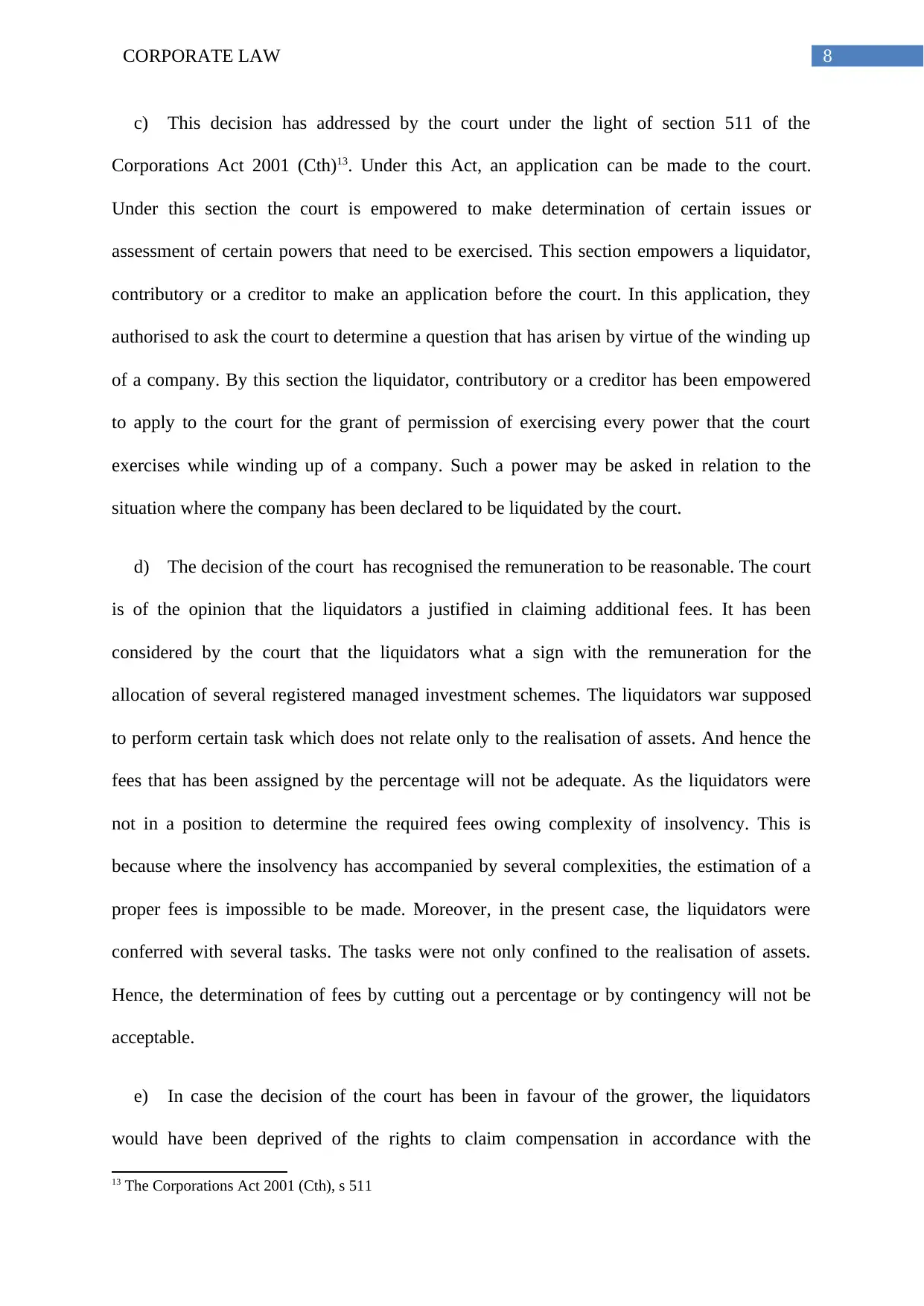
8CORPORATE LAW
c) This decision has addressed by the court under the light of section 511 of the
Corporations Act 2001 (Cth)13. Under this Act, an application can be made to the court.
Under this section the court is empowered to make determination of certain issues or
assessment of certain powers that need to be exercised. This section empowers a liquidator,
contributory or a creditor to make an application before the court. In this application, they
authorised to ask the court to determine a question that has arisen by virtue of the winding up
of a company. By this section the liquidator, contributory or a creditor has been empowered
to apply to the court for the grant of permission of exercising every power that the court
exercises while winding up of a company. Such a power may be asked in relation to the
situation where the company has been declared to be liquidated by the court.
d) The decision of the court has recognised the remuneration to be reasonable. The court
is of the opinion that the liquidators a justified in claiming additional fees. It has been
considered by the court that the liquidators what a sign with the remuneration for the
allocation of several registered managed investment schemes. The liquidators war supposed
to perform certain task which does not relate only to the realisation of assets. And hence the
fees that has been assigned by the percentage will not be adequate. As the liquidators were
not in a position to determine the required fees owing complexity of insolvency. This is
because where the insolvency has accompanied by several complexities, the estimation of a
proper fees is impossible to be made. Moreover, in the present case, the liquidators were
conferred with several tasks. The tasks were not only confined to the realisation of assets.
Hence, the determination of fees by cutting out a percentage or by contingency will not be
acceptable.
e) In case the decision of the court has been in favour of the grower, the liquidators
would have been deprived of the rights to claim compensation in accordance with the
13 The Corporations Act 2001 (Cth), s 511
c) This decision has addressed by the court under the light of section 511 of the
Corporations Act 2001 (Cth)13. Under this Act, an application can be made to the court.
Under this section the court is empowered to make determination of certain issues or
assessment of certain powers that need to be exercised. This section empowers a liquidator,
contributory or a creditor to make an application before the court. In this application, they
authorised to ask the court to determine a question that has arisen by virtue of the winding up
of a company. By this section the liquidator, contributory or a creditor has been empowered
to apply to the court for the grant of permission of exercising every power that the court
exercises while winding up of a company. Such a power may be asked in relation to the
situation where the company has been declared to be liquidated by the court.
d) The decision of the court has recognised the remuneration to be reasonable. The court
is of the opinion that the liquidators a justified in claiming additional fees. It has been
considered by the court that the liquidators what a sign with the remuneration for the
allocation of several registered managed investment schemes. The liquidators war supposed
to perform certain task which does not relate only to the realisation of assets. And hence the
fees that has been assigned by the percentage will not be adequate. As the liquidators were
not in a position to determine the required fees owing complexity of insolvency. This is
because where the insolvency has accompanied by several complexities, the estimation of a
proper fees is impossible to be made. Moreover, in the present case, the liquidators were
conferred with several tasks. The tasks were not only confined to the realisation of assets.
Hence, the determination of fees by cutting out a percentage or by contingency will not be
acceptable.
e) In case the decision of the court has been in favour of the grower, the liquidators
would have been deprived of the rights to claim compensation in accordance with the
13 The Corporations Act 2001 (Cth), s 511
⊘ This is a preview!⊘
Do you want full access?
Subscribe today to unlock all pages.

Trusted by 1+ million students worldwide
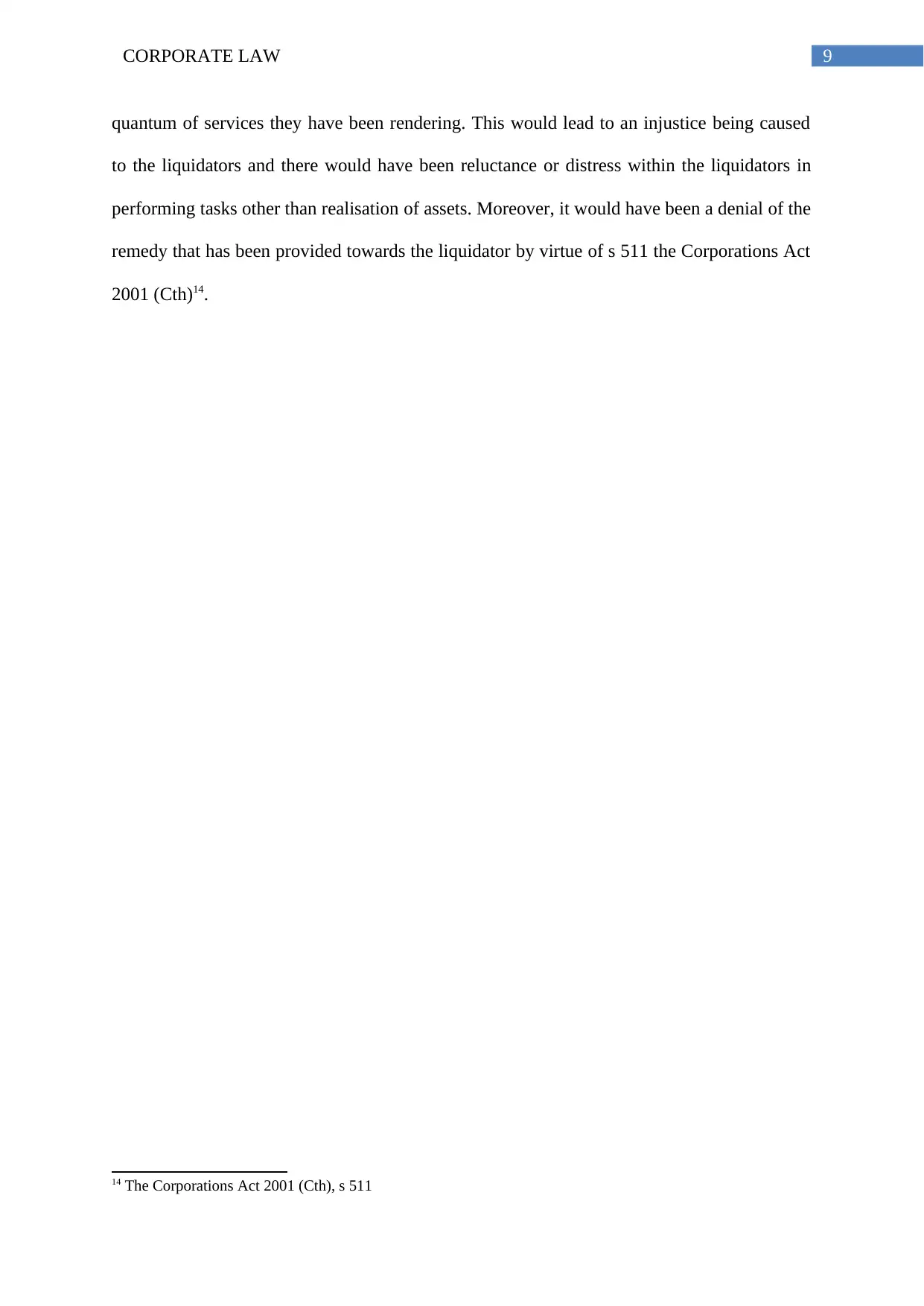
9CORPORATE LAW
quantum of services they have been rendering. This would lead to an injustice being caused
to the liquidators and there would have been reluctance or distress within the liquidators in
performing tasks other than realisation of assets. Moreover, it would have been a denial of the
remedy that has been provided towards the liquidator by virtue of s 511 the Corporations Act
2001 (Cth)14.
14 The Corporations Act 2001 (Cth), s 511
quantum of services they have been rendering. This would lead to an injustice being caused
to the liquidators and there would have been reluctance or distress within the liquidators in
performing tasks other than realisation of assets. Moreover, it would have been a denial of the
remedy that has been provided towards the liquidator by virtue of s 511 the Corporations Act
2001 (Cth)14.
14 The Corporations Act 2001 (Cth), s 511
Paraphrase This Document
Need a fresh take? Get an instant paraphrase of this document with our AI Paraphraser
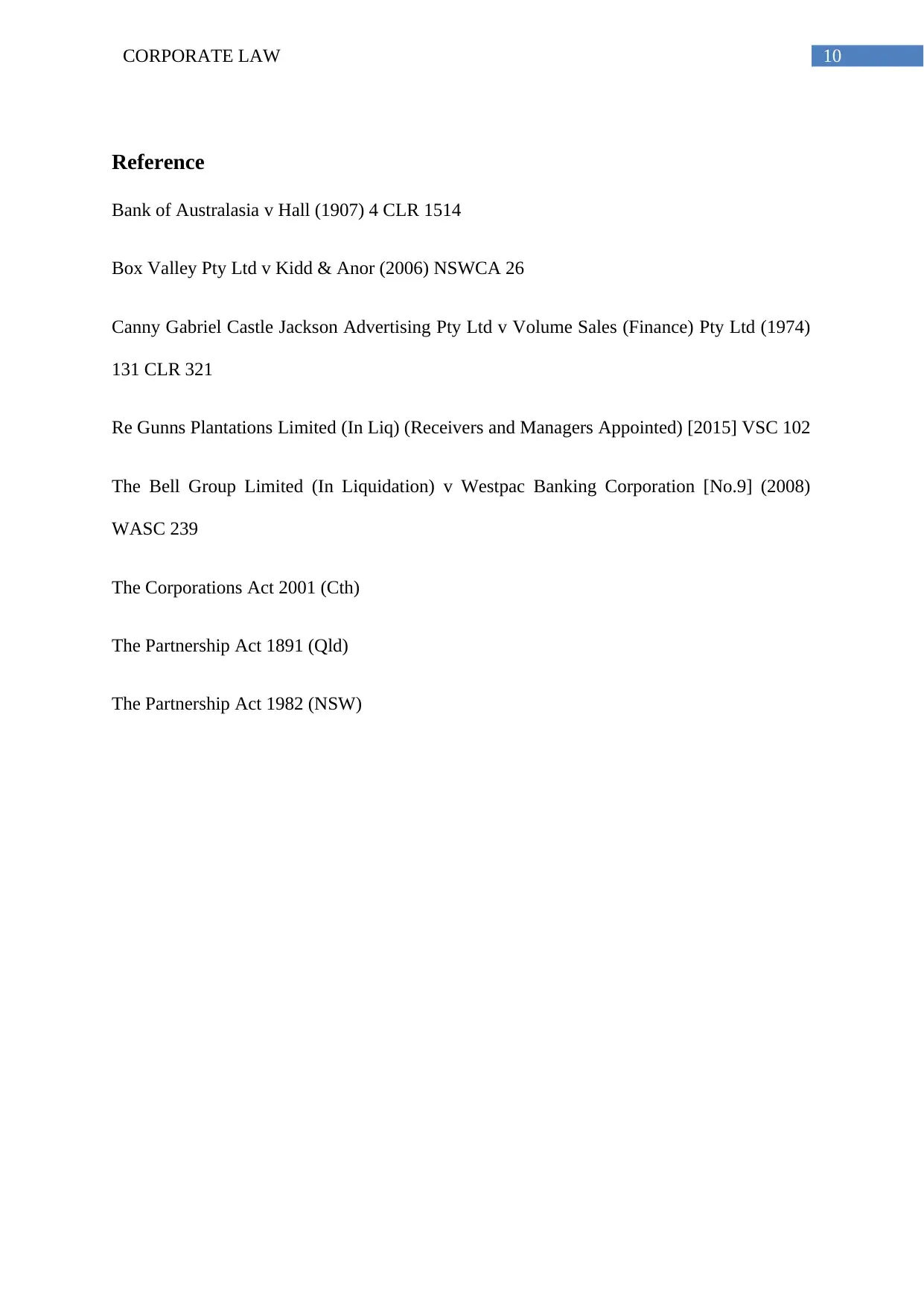
10CORPORATE LAW
Reference
Bank of Australasia v Hall (1907) 4 CLR 1514
Box Valley Pty Ltd v Kidd & Anor (2006) NSWCA 26
Canny Gabriel Castle Jackson Advertising Pty Ltd v Volume Sales (Finance) Pty Ltd (1974)
131 CLR 321
Re Gunns Plantations Limited (In Liq) (Receivers and Managers Appointed) [2015] VSC 102
The Bell Group Limited (In Liquidation) v Westpac Banking Corporation [No.9] (2008)
WASC 239
The Corporations Act 2001 (Cth)
The Partnership Act 1891 (Qld)
The Partnership Act 1982 (NSW)
Reference
Bank of Australasia v Hall (1907) 4 CLR 1514
Box Valley Pty Ltd v Kidd & Anor (2006) NSWCA 26
Canny Gabriel Castle Jackson Advertising Pty Ltd v Volume Sales (Finance) Pty Ltd (1974)
131 CLR 321
Re Gunns Plantations Limited (In Liq) (Receivers and Managers Appointed) [2015] VSC 102
The Bell Group Limited (In Liquidation) v Westpac Banking Corporation [No.9] (2008)
WASC 239
The Corporations Act 2001 (Cth)
The Partnership Act 1891 (Qld)
The Partnership Act 1982 (NSW)
1 out of 11
Related Documents
Your All-in-One AI-Powered Toolkit for Academic Success.
+13062052269
info@desklib.com
Available 24*7 on WhatsApp / Email
![[object Object]](/_next/static/media/star-bottom.7253800d.svg)
Unlock your academic potential
Copyright © 2020–2025 A2Z Services. All Rights Reserved. Developed and managed by ZUCOL.





